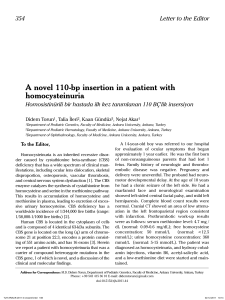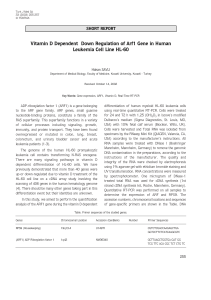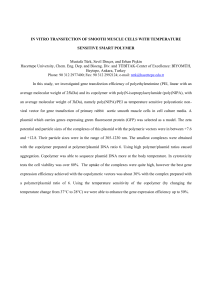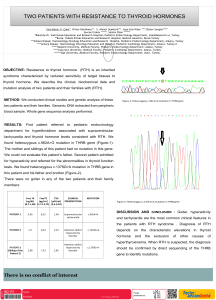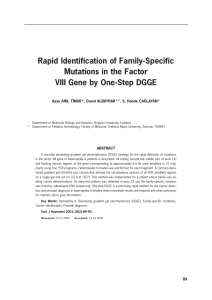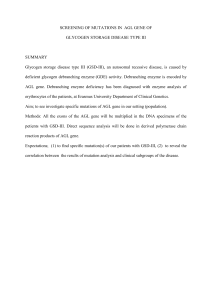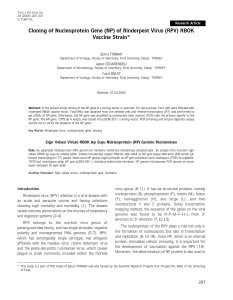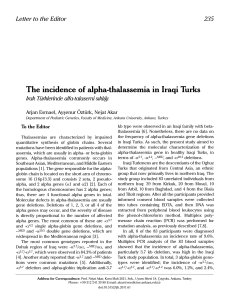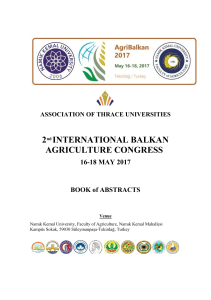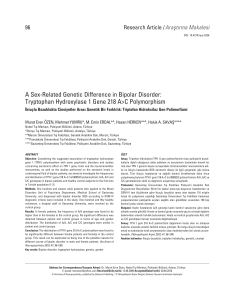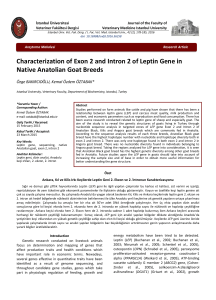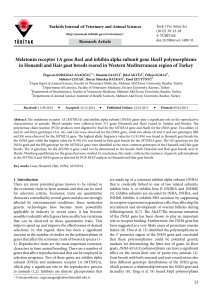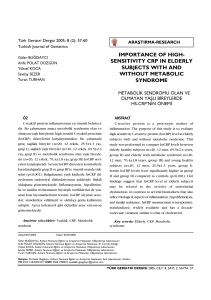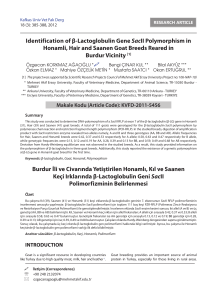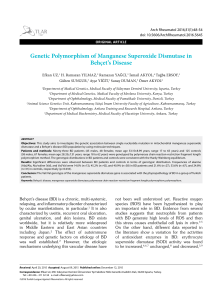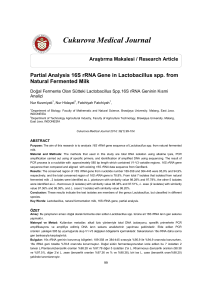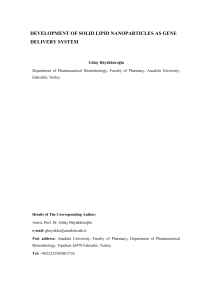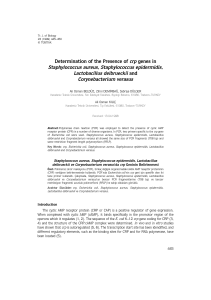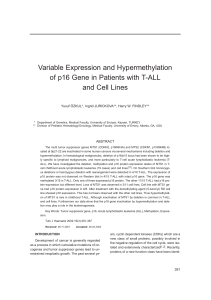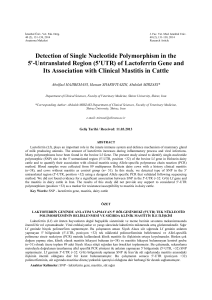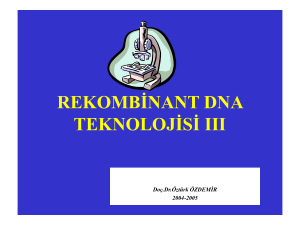Sequence Variant in the LPIN1 gene in Patients with Metabolic
advertisement
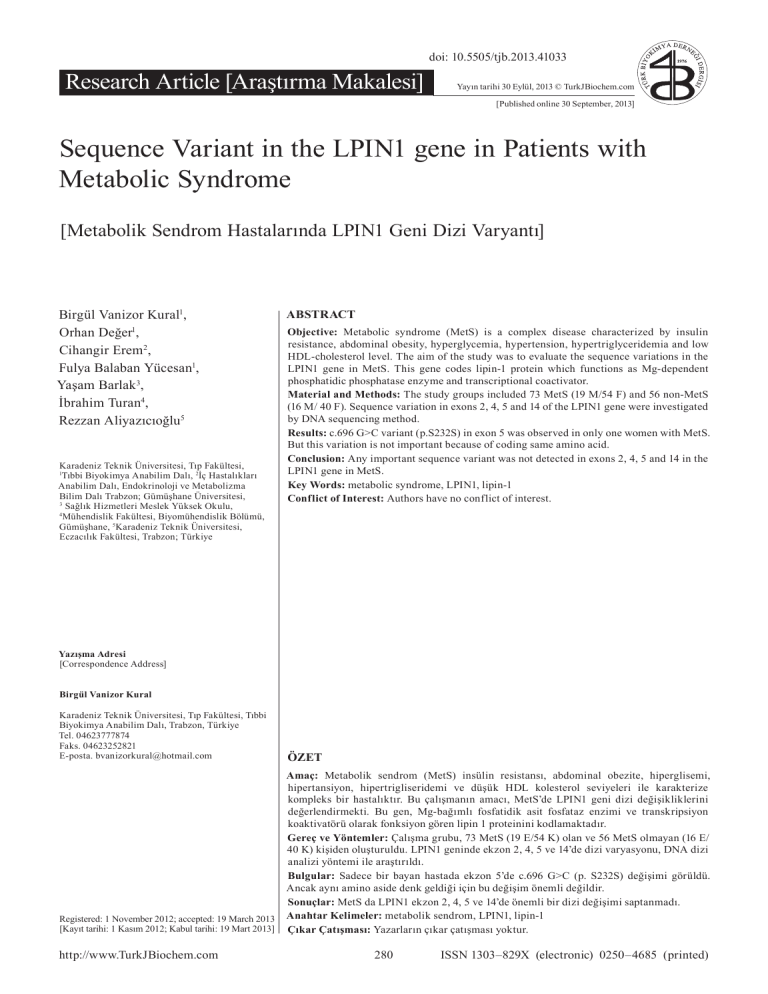
ORJİNAL doi: 10.5505/tjb.2013.41033 Research Article [Araştırma Makalesi] Yayın tarihi 30 Eylül, 2013 © TurkJBiochem.com [Published online 30 September, 2013] Birgül Vanizor Kural1, Orhan Değer1, Cihangir Erem2, Fulya Balaban Yücesan1, Yaşam Barlak3, İbrahim Turan4, Rezzan Aliyazıcıoğlu5 Karadeniz Teknik Üniversitesi, Tıp Fakültesi, Tıbbi Biyokimya Anabilim Dalı, 2İç Hastalıkları Anabilim Dalı, Endokrinoloji ve Metabolizma Bilim Dalı Trabzon; Gümüşhane Üniversitesi, 3 Sağlık Hizmetleri Meslek Yüksek Okulu, 4 Mühendislik Fakültesi, Biyomühendislik Bölümü, Gümüşhane, 5Karadeniz Teknik Üniversitesi, Eczacılık Fakültesi, Trabzon; Türkiye 1 1976 1. ÖRNEK ABSTRACT Objective: Metabolic syndrome (MetS) is a complex disease characterized by insulin resistance, abdominal obesity, hyperglycemia, hypertension, hypertriglyceridemia and low HDL-cholesterol level. The aim of the study was to evaluate the sequence variations in the LPIN1 gene in MetS. This gene codes lipin-1 protein which functions as Mg-dependent phosphatidic phosphatase enzyme and transcriptional coactivator. Material and Methods: The study groups included 73 MetS (19 M/54 F) and 56 non-MetS (16 M/ 40 F). Sequence variation in exons 2, 4, 5 and 14 of the LPIN1 gene were investigated by DNA sequencing method. Results: c.696 G>C variant (p.S232S) in exon 5 was observed in only one women with MetS. But this variation is not important because of coding same amino acid. Conclusion: Any important sequence variant was not detected in exons 2, 4, 5 and 14 in the LPIN1 gene in MetS. Key Words: metabolic syndrome, LPIN1, lipin-1 Conflict of Interest: Authors have no conflict of interest. Yazışma Adresi [Correspondence Address] Birgül Vanizor Kural Karadeniz Teknik Üniversitesi, Tıp Fakültesi, Tıbbi Biyokimya Anabilim Dalı, Trabzon, Türkiye Tel. 04623777874 Faks. 04623252821 E-posta. bvanizorkural@hotmail.com ÖZET Registered: 1 November 2012; accepted: 19 March 2013 [Kayıt tarihi: 1 Kasım 2012; Kabul tarihi: 19 Mart 2013] Amaç: Metabolik sendrom (MetS) insülin resistansı, abdominal obezite, hiperglisemi, hipertansiyon, hipertrigliseridemi ve düşük HDL kolesterol seviyeleri ile karakterize kompleks bir hastalıktır. Bu çalışmanın amacı, MetS’de LPIN1 geni dizi değişikliklerini değerlendirmekti. Bu gen, Mg-bağımlı fosfatidik asit fosfataz enzimi ve transkripsiyon koaktivatörü olarak fonksiyon gören lipin 1 proteinini kodlamaktadır. Gereç ve Yöntemler: Çalışma grubu, 73 MetS (19 E/54 K) olan ve 56 MetS olmayan (16 E/ 40 K) kişiden oluşturuldu. LPIN1 geninde ekzon 2, 4, 5 ve 14’de dizi varyasyonu, DNA dizi analizi yöntemi ile araştırıldı. Bulgular: Sadece bir bayan hastada ekzon 5’de c.696 G>C (p. S232S) değişimi görüldü. Ancak aynı amino aside denk geldiği için bu değişim önemli değildir. Sonuçlar: MetS da LPIN1 ekzon 2, 4, 5 ve 14’de önemli bir dizi değişimi saptanmadı. Anahtar Kelimeler: metabolik sendrom, LPIN1, lipin-1 Çıkar Çatışması: Yazarların çıkar çatışması yoktur. http://www.TurkJBiochem.com 280 DER AD RNN MYYA İM EE Kİ 1976 K BİİYYO RRK O TTÜÜ RK BİYO TÜ [Metabolik Sendrom Hastalarında LPIN1 Geni Dizi Varyantı] YA DERN İM E DERGİSİ Ğİ K RG GİİSSİ ER DE D İ Ğİİ Ğ Sequence Variant in the LPIN1 gene in Patients with Metabolic Syndrome ISSN 1303–829X (electronic) 0250–4685 (printed) 2. ÖRNEK Introduction The metabolic syndrome (syndrome X) (MetS) is a constellation of clinical and biochemical abnormalities characterized by dyslipidemia [hypertriglyceridemia and decreased HDL-C (high density lipoprotein cholesterol)], hypertension, impaired glucose tolerance and central obesity [1, 2]. Other metabolic abnormalities associated with MetS are abnormal weight distribution, inflammation, microalbuminuria, hyperuricemia, nephropathy, low tissue plasminogen activator and abnormalities of fibrinolysis and of coagulation [3, 4]. Thereby, this syndrome has been identified as a multiplex risk factor for cardiovascular diseases [5]. Lipin-1 is Mg2+-dependent “type 1” phosphatidic acid phosphatase (PAP1; 3-sn-phosphatidic acid phoshohydrolyse, EC 3.1.3.4) that dephosphorylate phosphatidic acid (PA) to generate diacylglycerol which is the immediate precursor of triacylglycerol, phosphatidylcholine, and phosphatidylethanolamine [6, 7]. Moreover, lipin-1 acts as a transcriptional coactivator/ corepressor for metabolic nuclear receptors regulating fatty acid metabolism in liver such as peroxisome proliferator-activated receptor α (PPARα) and PPARγ coactivator 1α (PGC-1α) [6, 8]. In the presence of elevated fatty acid levels within the cell, lipin proteins translocate from the cytosol to the endoplasmic reticulum membrane to metabolize PA [9]. Lipin-1 is abundantly expressed in adipose tissue, skeletal muscle and liver, to regulate lipid metabolism and glucose homeostasis [10, 11]. Therefore, the lack of lipin-1 prevents differentiation of human adipocyte precursor cells in vitro and causes lipodystrophy syndrome in vivo. On the other hand, lipin-1 polymorphisms have been associated with numerous metabolic traits, including insulin and glucose levels, resting metabolic rate and systolic blood pressure [12]. The increased lipin-1 expression in adipose tissue is associated with enhanced insulin sensitivity [13]. In addition, lipin-1 acts as a key integrator of hormonal signals to the liver [14]. Therefore, fasting, diabetes, high fat diet, chronic alcoholism, statin and glucocorticoid intake lead to increase of hepatic lipin-1 expression [15]. In liver, lipin-1 protein also involve in formation and secretion of very low density lipoprotein [14, 16]. Human lipin-1 protein is encoded by the LPIN1 gene (MIM605518, Entrez Gene ID 23175) which is expressed in three isoforms including lipin-1α (890 amino acids), lipin1β (926 amino acids) and lipin-1γ (916 amino acids) [6, 14]. LPIN1 gene polymorphisms were associated with abnormal insulin, high-, low- density lipoprotein and total cholesterol levels, suggesting its role in lipid metabolism and pathogenesis of type 2 diabetes and MetS [17]. The aim of the study was to analyze the LPIN1 gene sequence variants and their relationship with MetS diagnostic criteria. Among 20 exons of LPIN1 gene, Turk J Biochem, 2013; 38 (3) ; 280–285 exons 2, 4, 5 and 14 were particularly selected due to reported polymorphisms in these exons [18]. Materials and Methods Study Population The study was carried out in the Departments of Medical Biochemistry and Internal Medicine of the Faculty of Medicine of Karadeniz Technical University. All the participants gave informed consents and the study protocol was approved by the Local Ethical Board of the Faculty of Medicine (No.2006/25). The subjects were considered to have MetS if they had any three or more of the following criteria of National Cholesterol Education Program (NCEP)/Adult Treatment Panel (ATP) III [19]; Abdominal obesity: Waist circumference >102 cm in men and >88 cm in women. Hypertriglyceridemia: Serum triglycerides level ≥ 150 mg/dL (1.69 mmol/L). (TG) Low HDL-C: <40 mg/dL (1.04 mmol/L) in men and <50 mg/dL (1.29 mmol/L) in women. High blood pressure: Systolic blood pressure (SBP) ≥ 130 mmHg and/or diastolic blood pressure (DBP) ≥ 85 mmHg or on treatment for hypertension. High fasting blood glucose: Serum glucose level ≥ 110 mg/dL (6.1 mmol/L) or on treatment for diabetes. Waist circumference (WC) was measured in duplicate at the narrowest horizontal point between costal margin and iliac crests at the end of normal expiration to the nearest 0.1 cm. SBP and DBP were measured thrice in sitting position after 15 min rest, and the mean value was taken for all cases. Participants were advised to avoid caffeinated beverages and exercise for at least 30 min before. The study groups included 73 patients with MetS (19 men and 54 women) and 45 non-MetS healthy volunteers (16 men and 40 women). The patient group has the criteria in the following ratio: Abdominal obesity 73/73, hypertriglyceridemia 71/73, low HDL-C 64/73, hypertension 67/73 and high fasting glucose 28/73. Among MetS patients, 14 of them had all 5 criteria and the others had 4 criteria. Determinations of the Biochemical Parameters Blood samples were collected after 10–12 h fasting and the sera were separated by centrifugation. Aliquots of sera were then taken and stored at −80 °C until the tests were performed. Serum TG levels were measured by using a glycerol oxidase enzymatic method. HDLcholesterol by a cholesterol oxidase enzymatic method in supernatant after precipitation with phosphotungstic acid–MgCl2; fasting serum glucose was measured by using an enzymatic (glucose oxidase) colorimetric 281 Vanizor Kural et al. method. All above measurements were performed with an autoanalyzer (Roche, Modular, Switzerland). DNA Sequencing of Exons 2, 4, 5 and 14 of the LPIN1 Gene DNA was isolated from whole blood samples by using Invisorb Spin Blood Mini Kit (Cat No: 1031100200; Berlin, Germany). Polymerase chain reaction (PCR) steps (with little modification) and primer sequences of exons were chosen according to Cao and Hegele [18]. Amplification conditions for the LPIN1 exons were as follows: 94°C for 5 min, followed by 30 cycles of 60 s each at 94°C, 60°C, and 72°C and ending with a single 10-min extension step at 72°C. Primer sequences were as follows: Exon 2 F: 5’- CTT GGA TTA ATT GTG TGT CTG TGT G -3’ R: 5’- TTT CAA TTA GTC ACT GTC AGT TCC G- 3’ Exon 4 F: 5’- CAA GGC CCT GCT TCT TAT ACC T - 3’ R : 5’- AGG ATT TAT GGG GGA AAA GTTC - 3’ Exon 5 F: 5’- CAA AGC ACT TAG AGC TAA TCA AGA AA - 3’ R: 5’ – TGA CTT CTA AGC CTC TGC ACT G - 3’ Exon 14 F: 5’ - ATT TTT CAT GGC TAC CCA GAT G - 3’ R: 5’ - AAA CCT CAT GTG CTC ACA ACA C - 3’ The PCR products were purified by using purification kit (Invisorb Spin PCRapid Kiti-Invitek Lot no: BC070014). BigDye Cycle Sequencing v3.1 Kit (Applied Biosystems, California, USA) was used for cycle sequencing reactions. Cycle sequencing was performed for 25 cycles of 96°C for 10 s, 50°C for 5 s, and 60°C for 4 min. The products were repurified using Sephadex G-50 (Sigma-Aldrich, Germany). The final products were used for DNA sequencing analysis by ABI PRISM 3130 Genetic Analyzer. BioEdit (BioEdit, Carlsbad, CA) software mutation charts were used for the sequencing analysis. Statistical Analysis Data were expressed as the means and standard deviations (S.D.). The distributions of the variables in study groups were assessed by Kolmogorov–Simirnov test. Statistical differences between data of MetS and non-MetS groups were determined according to Student’s t-test (parametric). P-values less than 0.05 were considered to be statistically significant. Results The values of anthropometric and biochemical parameters of MetS and non-MetS individuals were shown in Table 1. The values of WC, SBP and DBP and the levels of glucose and TG were significantly higher but HDL-C was lower in MetS group than in non-MetS Turk J Biochem, 2013; 38 (3) ; 280–285 group. As a result of DNA sequencing analysis of the LPIN1 exons, it was observed that only one patient with 5 criteria had c.696 G>C transition in exon 5 of LPIN1 with SNP number rs145180224. Since this transition doesn’t change the amino acid sequence in protein level, it is a silent variation (p.S232S) (Figure 1). The values of the anthropometric and biochemical parameters belong to this patient were given in Table 2. Any other variant was not obtained in any exons in both MetS and nonMetS group. Discussion Lipin-1 protein, a product of the LPIN1 gene, modulates lipid metabolism and glucose homeostasis [10]. While cytosolic lipin-1 acts as a PAP enzyme converting phosphatidate to diacylglycerol during triglyceride biosynthesis, nucleotic lipin-1 acts as a transcriptional coactivator interacting with PPARα and PGC-1α complex that modulates fatty acid oxidation gene expression [20]. In humans, variations in lipin-1 expression levels and gene polymorphisms are associated with insulin sensitivity, metabolic rate, hypertension, and risk for the metabolic syndrome [21]. In addition, adipose tissue LPIN1 expression levels were reported to reduce in obesity and the metabolic syndrome [22]. In this study, the sequence of exon 2, 4, 5 and 14 of the LPIN1 gene were screened by DNA sequencing method in MetS and non-MetS groups. MetS group had significantly higher values of WC, SBP, DBP, glucose and TG but lower values of HDL-C than non-MetS group (p<0.001) (Table 1). 14 of the MetS subjects fulfilled all 5 criteria and the others fulfilled criteria. As a result, sequence variation was not detected in the exons of LPIN1 analyzed in MetS and non-MetS subjects, except c.696 G>C (SNP rs145180224) (p.S232S) variant seen in exon 5 of one MetS patient (Figure 1). The women with c.696 G>C variant in exon 5 in LPIN1 gene had 5 of the MetS criteria (Table 2). This variant codes same amino acid (silent mutation) in human lipin-1 protein having 890 amino acids. Even though it was not detected in our study, many single nucleotide polymorphisms (SNPs) in exons 2, 4, 5 and 14 of the LPIN1 were reported in PubMed [23]. In addition, there are also some studies reporting many variants in LPIN1 gene. For instance, Cao and Hegele [18] identified a nonsynonymous SNP 2211C>T in exon 14 in the lipodystrophy syndrome and in normal control groups. Fawcett et al. [24] reported S232S (G>C) (as detected in the present study), A353T (G>A), V494M (G>A), R552K (G>A), G582R (G>A) and P610S (C>T) SNPs and found the rare nonsynonymous variants A353T, R552K, and G582R in severely insulin-resistant patients, but did not found any association between LPIN1 SNPs and fasting insulin. According to Zhang et al. [25], rs16857876 and rs11695610 SNPs within the LPIN1 282 Vanizor Kural et al. Figure 1. The electrophoregram of the LPIN1 gene exon 5 of MetS patient with c.696 G>C variant, obtained with ABI PRISM 3130 Genetic Analyzer. Figure 1. The electrophoregram of the LPIN1 gene exon 5 of MetS patient with c.696 G>C Table 1. The values of the anthropometric measurements and the biochemical parameters in MetS and non-MetS groups. variant, obtained with ABI PRISM 3130 Genetic Analyzer. non-MetS MetS N=56 N=73 F/M 40/16 54/19 Age (years) 33 ± 8 52 ± 15 < 0.001 WC (cm) 78 ± 9 106 ± 11 < 0.001 SBP (mmHg) 113 ± 9 150 ± 28 < 0.001 DBP (mmHg) 73 ± 7 93 ± 16 < 0.001 TG (mg/dL) 68 ± 23 233 ± 96 < 0.001 HDL-C (mg/dL) 66 ± 12 41 ± 7 < 0.001 Glucose (mg/dL) 83 ± 9 120 ± 68 < 0.001 p <0.05 F: Female, M: Men, WC: Waist circumference, SBP: Systolic blood pressure, DBP: Diastolic blood pressure, TG: Triglyceride, HDL-C: High density lipoprotein-cholesterol. region were associated with type-2 diabetes in Chinese population. But in another study with Chinese population, it was reported that the LPIN1 gene seemed not to be a major susceptibility gene for type-2 diabetes or related metabolic phenotypes [26]. Burgdorf et al. [27] determined that LPIN1 rs33997857, rs6744682, and rs6708316 did not associate with type-2 diabetes, obesity, or related diseases in the Danish population. Loos et Turk J Biochem, 2013; 38 (3) ; 280–285 al. [20] explained that LPIN1 IVS18 + 181C>T variant (rs2716609) showed a strong association with fasting insulin levels and with measures of adiposity and fat distribution. In addition, they suggested that LPIN1 gene contributes to variation in obesity-related phenotypes, potentially in an age-dependent manner. Suviolahti et al. [28] found the strong negative correlations of lipin expression with glucose and insulin in the patients with 283 Vanizor Kural et al. Table 2. The values of the anthropometric measurements and the biochemical parameters of MetS patient with c.696 G>C variant in exon 5 of the LPIN1 gene. Age (years) 54 WC (cm) 105 SBP (mmHg) 130 DBP (mmHg) 90 TG (mg/dL) 172 HDL-C (mg/dL) Glucose (mg/dL) 40 119 dyslipidemia. As seen in the given studies above there are conflicting results about the LPIN1 gene and insulin resistance. To the best of our knowledge, there was no study in Turkish population about the lipin-1 protein and the LPIN1 gene. The reason why the previously reported polymorphisms or mutations of LPIN1 exons were not detected in this current study can be explained by polymorphisms specific to Turkish population of this particular gene. Another reason may be the small number of subjects. In addition, although the LPIN1 gene has 20 exons, only 4 exons (2, 4, 5 and 14) were screened. The limitations of this present study were the number of the subjects and the limited exons. In conclusion, no important sequence variation in exons of the LPIN1 gene was associated with MetS. But the current study suggested that the new study with large number of subjects is necessary to detect the genetic variation of the LPIN1 in Turkish population. Acknowledgements The authors thank Karadeniz Technical University Research Fund (Project no: 2006.114.001.2, Project No: 2003.114.003.5 and Project No: 2008.114.001.12) for supplying financial support. In addition, thanks Arif HACIHASANOĞLU, Ilgın HOŞVER and Mihriban AYVAZ for their help in collecting of blood samples, and thanks Assoc. Prof. Ersan KALAY for technical support to analyze DNA sequences. Current address of İbrahim Turan is Gümüşhane Üniversitesi, Mühendislik Fakültesi, Genetik ve Biyomühendislik Bölümü, Gümüşhane; and current address of Yaşam Barlak is Gümüşhane Üniversitesi, Sağlık Yüksek Okulu, Gümüşhane. Conflict of interest: Authors have no conflict of interest. References [1] Aguilera CM, Gil-Campos M, Cañete R, Gil A. Alterations in plasma and tissue lipids associated with obesity and metabolic syndrome. Clin Sci (Lond) 2008; 114(3):183-93. [2] Alshehri AM. Metabolic syndrome and cardiovascular risk. J Family Community Med 2010; 17(2):73-8. [3] Ford ES, Giles WH. A comparison of the prevalence of the metabolic syndrome using two proposed definitions. Diabetes Care 2003; 26(3):575-81. [4] Bee YT Jr, Haresh KK, Rajibans S. Prevalence of Metabolic Syndrome among Malaysians using the International Diabetes Federation, National Cholesterol Education Program and Modified World Health Organization Definitions. Malays J Nutr 2008; 14(1):65-77. [5] Grundy SM, Brewer HB Jr, Cleeman JI, Smith SC Jr, Lenfant C. American Heart Association; National Heart, Lung, and Blood Institute. Definition of metabolic syndrome: Report of the National Heart, Lung, and Blood Institute/American Heart Association conference on scientific issues related to definition. Circulation 2004 27; 109(3):433-8. [6] Han GS, Carman GM. Characterization of the human LPIN1encoded phosphatidate phosphatase isoforms. J Biol Chem 2010; 285(19):14628-38. [7] Burgdorf C, Hänsel L, Heidbreder M, Jöhren O, Schütte F, et al. Suppression of cardiac phosphatidate phosphohydrolase 1 activity and lipin mRNA expression in Zucker diabetic fatty rats and humans with type 2 diabetes mellitus. Biochem Biophys Res Commun 2009; 390(1):165-70. [8] Reue K. The Lipin Family: Mutations and Metabolism. Curr Opin Lipidol 2009; 20(3): 165–70. [9] Reue K, Dwyer JR. Lipin proteins and metabolic homeostasis. J Lipid Res. 2009; 50 Suppl: S109-14. [10] Ishimoto K. Lipin 1 in lipid metabolism. Yakugaku Zasshi 2011; 131(8):1189-94. [11] Reue K, Zhang P. The lipin protein family: dual roles in lipid biosynthesis and gene expression. FEBS Lett 2008; 582(1):90-6. [12] González CR, Novelle MG, Caminos JE, Vázquez MJ, Luque RM, et al. Regulation of lipin1 by nutritional status, adiponectin, sex and pituitary function in rat white adipose tissue. Physiol Behav 2012; 105(3):777-83. [13] Zhang P, O’Loughlin L, Brindley DN, Reue K. Regulation of lipin-1 gene expression by glucocorticoids during adipogenesis. J Lipid Res 2008; 49(7):1519-28. [14] Bou Khalil M, Blais A, Figeys D, Yao Z. Lipin - The bridge between hepatic glycerolipid biosynthesis and lipoprotein metabolism. Biochim Biophys Acta 2010; 1801(12):1249-59. [15] Harris TE, Finck BN. Dual function lipin proteins and glycerolipid metabolism. Trends Endocrinol Metab 2011; 22(6):226-33. [16] Bou Khalil M, Sundaram M, Zhang HY, Links PH, Raven JF, et al. The level and compartmentalization of phosphatidate phosphatase-1 (lipin-1) control the assembly and secretion of hepatic VLDL. J Lipid Res 2009; 50(1):47-58. [17] Bego T, Dujic T, Mlinar B, Semiz S, Malenica M, et al. Association of PPARG and LPIN1 gene polymorphisms with metabolic syndrome and type 2 diabetes. Med Glas Ljek komore Zenicko-doboj kantona 2011; 8(1):76-83. [18] Cao H, Hegele RA. Identification of single-nucleotide polymorphisms in the human LPIN1 gene. J Hum Genet 2002; 47(7):370-2. [19] Expert Panel on Detection, Evaluation, and Treatment of High Blood Cholesterol in Adults. Executive Summary of the Third Report of the National Cholesterol Education Program Turk J Biochem, 2013; 38 (3) ; 280–285 284 Vanizor Kural et al. (NCEP) Expert Panel on Detection, Evaluation, and Treatment of High Blood Cholesterol in Adults (Adult Treatment Panel III). JAMA 2001; 285(19):2486-97. [20] Loos RJ, Rankinen T, Pérusse L, Tremblay A, Després JP, et al. Association of lipin 1 gene polymorphisms with measures of energy and glucose metabolism. Obesity (Silver Spring) 2007; 15(11):2723-32. [21] Reue K, Brindley DN. Thematic Review Series: Glycerolipids. Multiple roles for lipins/phosphatidate phosphatase enzymes in lipid metabolism. J Lipid Res 2008; 49(12):2493-503. [22] Van Harmelen V, Rydén M, Sjölin E, Hoffstedt J. A role of lipin in human obesity and insulin resistance: relation to adipocyte glucose transport and GLUT4 expression. J Lipid Res 2007; 48(1):201-6. [23] LPIN1 lipin 1 [Homo sapiens]. Gene ID: 23175, (18-Aug-2012). http://www.ncbi.nlm.nih.gov/nuccore/NG_012843.1?from=1&t o=97934&report=graph&content=5. [24] Fawcett KA, Grimsey N, Loos RJ, Wheeler E, Daly A, et al. Evaluating the role of LPIN1 variation in insulin resistance, body weight, and human lipodystrophy in U.K. Populations. Diabetes 2008; 57(9):2527-33. [25] Zhang R, Jiang F, Hu C, Yu W, Wang J, et al. Genetic variants of LPIN1 indicate an association with Type 2 diabetes mellitus in a Chinese population. Diabet Med 2013; 30(1):118-22. [26] Chang YC, Chang LY, Chang TJ, Jiang YD, Lee KC, at al. The associations of LPIN1 gene expression in adipose tissue with metabolic phenotypes in the Chinese population. Obesity (Silver Spring) 2010; 18(1):7-12. [27] Burgdorf KS, Sandholt CH, Sparsø T, Andersen G, Witte DR, at al. Studies of association between LPIN1 variants and common metabolic phenotypes among 17,538 Danes. Eur J Endocrinol 2010; 163(1):81-7. [28] Loos RJ, Rankinen T, Pérusse L, Tremblay A, Després JP, et al. Association of lipin 1 gene polymorphisms with measures of energy and glucose metabolism. Obesity (Silver Spring) 2007; 15(11):2723-32. [29] Suviolahti E, Reue K, Cantor RM, Phan J, Gentile M, et al. Cross-species analyses implicate lipin 1 involvement in human glucose metabolism. Hum Mol Genet 2006; 15(3):377 –86. Turk J Biochem, 2013; 38 (3) ; 280–285 285 Vanizor Kural et al.
